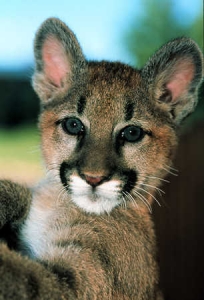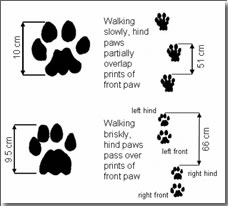 The cougar, or mountain lion, is North America’s largest wild cat. An adult male cougar weighs between 63 and 90 kg, and a female between 40 and 50 kg. Cougar are solitary, except for mothers with young. Their prey species include deer, wild sheep, elk, rabbits, birds and other small animals.
The cougar, or mountain lion, is North America’s largest wild cat. An adult male cougar weighs between 63 and 90 kg, and a female between 40 and 50 kg. Cougar are solitary, except for mothers with young. Their prey species include deer, wild sheep, elk, rabbits, birds and other small animals.
Most active at dusk and dawn, cougar can roam and hunt throughout the day or night in all seasons. They have ranges up to 300 sq km and may roam up to 80 km in a single day.
During late spring and summer, one to two year old cougar become independent of their mothers. While attempting to find a home range, these young cats often roam widely in search of an unoccupied territory. This is when they are most likely to come into contact with people.
Signs of Cougar Presence
 Although your chances of seeing one of these elusive cats is slim, you need to be aware of their existence when in cougar country. Cougar mark their territory along trails, under trees, or on the edge of a ridge. They use mounds of scraped and scratched earth, pine needles and other forest litter, soaked with urine and feces. The feces are usually large, partially covered and contain hair and bone fragments.
Although your chances of seeing one of these elusive cats is slim, you need to be aware of their existence when in cougar country. Cougar mark their territory along trails, under trees, or on the edge of a ridge. They use mounds of scraped and scratched earth, pine needles and other forest litter, soaked with urine and feces. The feces are usually large, partially covered and contain hair and bone fragments.
Cougar tracks look like those of a house cat, but are the size of a baseball. The tracks have four toes with three distinct lobes present at the base of the pad. Claws usually do not leave imprints. The front paw is always larger than the back paw mark.
Cougar are predators at the top of the food chain, and their actions are often unpredictable. Following these general guidelines will reduce the risk of cougar conflict.
If you meet a cougar DO NOT RUN. Back away slowly, always looking them in the eye. Sudden movement or flight may trigger an instinctive attack.
Never turn your back on a cougar – face the cat and remain upright
Do all you can to make yourself look bigger. Hold a coat, branch or any other object over your head, or wave it around. Don’t crouch down or try to hide
Yell, throw rocks, speak loudly and firmly. Convince the cougar that you are a threat, not prey
Always give the cougar an avenue of escape
If the cat attacks FIGHT BACK. Many people have survived cougar attacks by fighting back with anything they have, including rocks, sticks, fists, fishing poles, cameras, skateboards etc
Hiking in Cougar Country
- Hike in groups of two or more, and make enough noise to avoid surprising a cougar
- Be extremely alert when biking in cougar country – a human on a bike looks like a deer running to a big cat. You can’t hear anything coming if you are wearing ear buds with music playing
- Carry a sturdy walking stick and pepper spray to be used as a weapon if necessary
- Keep children close and under control
- Watch for cougar tracks and signs
- Check with the local park office about wildlife sightings before your trip
- If you stumble upon cougar kittens, leave the area immediately as the female will defend her young
Hiking with Children
- Cougar seem to be attracted to children, due to their high pitched voices, small size and erratic movements which are all similar to small prey animals.
- Talk to children and teach them what to do if they encounter a cougar. Encourage them to play in groups, and always supervise children playing outdoors in cougar country
- A dog is an effective early warning system, as they see, smell and hear a cougar sooner than people
- Pick children up off the ground immediately. Children frighten easily and their rapid movements may trigger an attack
Living in Cougar Country
Do not attract wildlife to your yard, especially deer, who will clean up under bird feeders
Never leave pet food outside, feed your pets indoors, and always bring your pets in at night
Place domestic livestock in an enclosed shed or barn at night
Pat Bumstead
See our Safety in Cougar Country for details on living with cougars.
Pat Bumstead
See our Safety in Cougar Country page on our website. There are thousands of cougar in North America, and you may hear of one or two attacks per year for the whole continent. Not a concern at all if people know what they’re doing before they o into cougar country!
Jill
Since seeing a sign about a cougar siting, I reluctantly gave up the trail for a road nearby–safer for someone running/biking by themselves (at least I read the odds a cougar will go on a road with activity are low). As to defense, I’ve read conflicting advice. Most articles say to look a cougar in the eye. But others say that reads as too aggressive and recommend staring at their feet. Lastly, the majority of articles suggest attacks on humans is rare.. how elusive cougars are.. afraid of humans, etc. and yet, every year or so, you hear of attacks.
Pat Bumstead
You have exactly the correct attitude to live in cougar country, and I wish more people were like you! Being cautious at night is totally correct. Try and make noise while you’re walking or hiking – just enough to let the sharp-eared cat know there is a human there. Cougar do not want to run into humans either, so let them know you’re on the trail and they’ll disappear into the bush away from your presence. They sleep during the day in trees, in rock piles or wherever they can be comfortable and are are still able to make a quick getaway if needed.
Chance meetings with cougars are extremely rare. The cat can hear you LONG before you can see him. Just make noise so he knows you’re there, and he will change his course to avoid you.
Carmen Badgley
I am concerned, recent cougar sightings in summit washington a suburb of Tacoma yet still rural area, have lead me to be a bit more cautious than usual during night time especially.
I was wondering where do cougars sleep during the day? Do they normally nap in trees or long grass ? And what can. I do to detour a chance meeting with one?
Pat Bumstead
Excellent story. Made the hair on my neck stand up from here.
fred johnson
Don I pan on Vancouver’s Island ,, one day a few years ago on a river my dog went to ground still as stone , then warning bells started going off in my brain , ifin you follow my meaning . I stood up , and slowly looked around as i turned my body . As i faced directly across the far bank , my eyes stopped and there was a mountain lion not 15 meters away . Just sitting there , studying me tip of the tail slightly twitching . I watched it as it watched me . Then i went back to panning . Never heard it come , never heard it go .
Pat Bumstead
No idea! You would have to contact a cougar biologist for answers on that one.
Bonnie M Dahl
Does cougar urine smell like domestic cats urine?
Don Jamieson
Living on Vancouver Island, home of cougars and sasquatch, I am of large prey size at 120lbs, and am hopng that I get to see one of each, from a very safe distance.
While in my idling car, with the windows up.
The local government building has a stuffed cougar that out-weights me, out-runs me, out-scares me, out-lasts me, and it’s quite dead !
Not a big fan of cats, never really have been, their eyes are….shudder….
Pat Bumstead
There are actually no sub-groups in the North American cougar population as they are all exactly the same. There can be variations in facial markings though, especially in juvenile cougars. You’re very lucky you have a French Mastiff and not a French Poodle or your story might have been vastly different!
Jeff
Jeff
I live in the state of Michigan In the very small town of Dansville. In the month of April 2013 I went out with our dog, a French Mastiff. Our home is on a long narrow lot. As the dog was doing her business I noticed what I thought was a large dog at the far end of the property. I began to walk toward the animal it turned to give a profile view. This allowed me to see the tail. This appendage was about as long as the rest of the body and was in constant movement. The dog came and stood touching me. Her body was quivering as she watched the cat advanced. The cat stopped about ten foot from us. The cat appeared to be slightly larger than the dog. The dog weighed about 110 lbs.
The cat was mostly tan in color. The face had symmetric markings centered around the eyes. We stared at each other for about 20 seconds; the cat looked first at me then at the dog then back at me. The cat then took a step back and walked slowly away. The dog and I stood still until the cat merged into the undergrowth and disappeared from view. We then walked back to the house. Pictures I have seen, of a cougar, appear to be a match except for the facial markings. A question for me is the facial marking associated with a sub-group?